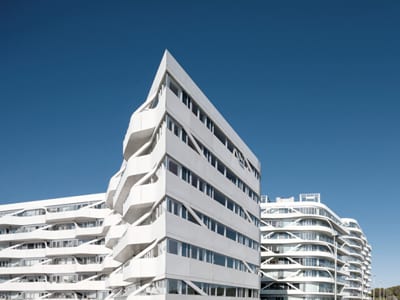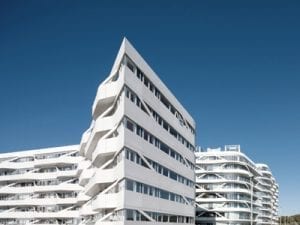Both universal landscapes and personal experiences are represented in a new publication that considers the wider effects of architectural tourism.
In times of increasingly uncertain and tumultuous geopolitics, it has never been more important to “think global, act local.” The catchphrase is usually attributed to the pioneering Scottish town planner and social activist Patrick Geddes, whose 1915 book Cities in Evolution discusses urban planning with respect to the human condition. In this unique text he argues the case for working with the environment and its local communities, instead of in opposition to them. This impulse – on the one hand favouring worldwide significance, whilst on the other demanding the immediate localised situation – is evident throughout the commodious Destination Architecture. This compendium offers 1,000 buildings from across the world – many small and medium-sized builds – selected for both their aesthetic qualities and their inventiveness, as a guide to cutting-edge contemporary living.
As to be expected in such a voluminous sampling, the buildings featured are thrillingly diverse in their approaches. As Phaidon’s editors note: “The buildings were selected for a host of reasons – beauty and purpose are certainly two of these. We included a lot of fantastic small builds that embody both these values.” These projects include Diébédo Francis Kéré’s (b. 1965) Centre for Earth Architecture in Mali, a structure with a cantilevered roof, which is sited on the crest of a dike that also encompasses a mosque. Its outline is compliantly sleek and pared back, using a local vocabulary and responding to the texture and fabric of the landscape, without compromising a view of the mosque. As well as its beautiful exterior qualities, the centre has been tailored to its function, and to the outside topographies. For example, the visitor centre, which includes three separate aspects, is triangulated into three different buildings connected by two roof surfaces. Meanwhile, all the walls and barrel vaults are made up of compressed earth, becoming highly suited to the climactic demands of the site, and acting as an efficient temperature regulator. Further to this, ventilation openings provide a natural flow of air so that the building conditioning works without mechanic backing. The overhanging roof acts as a canopy and provides effective outdoor spaces.
Whilst Kéré’s example responded functionally and critically to its organic needs, some of the featured structures literally reflect their surroundings, one example being the Nanjing Wanjing Garden Chapel in Jiangsu China, designed in 2014 by AZL. This small chapel, which is used by the Nanjing Union Theological Seminary, is located beside the Nanjing Riverfront. Its shapely, arresting exterior – two muted spires and a curve – are mirrored in the water, creating a near-symmetrical extension of the building’s form. Its exterior is formed of thin pillars of wood (like pencil shading on a fine drawing), and they allow light to flood the chapel’s luminous white interiors.
Further to these thematic connections throughout the book, the projects are arranged – as the title suggests – by their location. One of the merits of geographical representation is that it brings designs into conversation with one another, both on a neighbouring level and also more widely – they encourage patterns of what the theorists Rosa Braidotti and Pierre Joris call “nomadic thought,” reading dynamically across and through different social and political borders, paying attention to smaller, more recognisable contexts. The editors think of the book as a kind of field guide, “primarily a travel guide, so the most user-friendly format is to present the structures by place”, but this decision opens up more fruitful dialogues from a critical standpoint. What is the significance of similarities and differences within or, indeed, across borders? Destination Architecture draws up conversations about projects and the landscape – a relationship that is both connective and reciprocal. Examples of this include Isbjerget (2013), designed by seARCH, CEBRA, JDS architects and Louis Paillard, and Light*House (2012), which are both in Aarhus, Denmark. These works make use of light and their immediate position on the water, enabling them to reflect the waves and promote social spaces through the elements. They also seem to suggest a particular pairing with the contemporary aesthetic prevalent in Aarhus. Isberjget, for example, is realised through the dramatic shape of an iceberg, with playful angles and peaks, but with a sweeping elegance to its form, hosting diverse housing types in four L-shaped wings which contain more than 200 one- or two-storey apartments.
Another example that takes hold of light as an innovative mode of communication is Buckingham Gate (2013), London, which carries the façade of folding planes that reflect different types of light based on the time of day. This futuristic and forward-looking building is also sensitive to its surrounding environs – a historic area of London being extensively redeveloped and reconsidered. This indeed looks at the notion of temporality, change, and ultimately, progression.
Many of the examples also engage in ecologically sophisticated practices that respond to the fabric of the earth as a mediator for its own sustainability. As the editors point out: “This wasn’t the primary intention of the text, but we have included a swathe of buildings that respond to their environment in dynamic, engaging ways. The Romsdal Folk Museum (2016) by Reiulf Ramstad, is one such design: its spiky, zigzagged roof is produced to mirror Romsdal’s traditional pitch-roof. Elsewhere, 3XN’s Blue Planet Aquarium features an organic shape that is inspired by waves, and which mimics a whirlpool from above; a swirling path leads you into the entrance, creating an almost seamless transition from the surrounding water and fields.”
In an age where the image is ever more central to experience, part of the collection is likely to be recognisable or familiar to a wide audience because of its visual or even “likeable” appeal. As the editors note: “Some of the buildings might feature heavily on Instagram, say, because they have a fantastical form: Zaha Hadid, Herzog & de Meuron, Frank Gehry, OMA and Rem Koolhaas all come to mind. Specifically, we love OMA’s MahaNakhon Tower, Hadid’s Port House in Antwerp, Gehry’s Fondation Louis Vuitton in Paris, Herzog & de Meuron’s Hamburg Elbphilharmonie, and FR-EE’s Museo Soumaya — for their eye-popping forms.”
Phaidon’s publication promotes attention to the appreciation of architecture, positing the potential for exterior forms to be integrated into everyday life, perhaps as an activity or collective interest. Ultimately the publication asks: how can an engagement with buildings create wider, philosophical and recreational meaning – to international audiences – by inviting viewers to stop, visit and enjoy the physicality as opposed to simply reading about the design? This is something that is integral to the editorial approach: “We hope that the book appeals to architectural buffs, but also encourages people curious about design and culture more widely to seek out standout structures, just as they would a gallery, or store.”
With this approach in mind, the book’s structure capitalises on emerging audiences for tourism, and an interest in the spectacle of architecture. This is a trend that has significantly emerged in recent years, with audiences actively travelling to take in structures, has grown into a phenomenon, and a kind of awe-inspiring or personally fulfilling activity: “Particular styles – Brutalism, say – have really captured the wider public’s imagination, particularly through channels such as Instagram. Classical / landmark / iconic works have always been on travellers’ hit lists, but it’s a nice swing to see that contemporary buildings are being given the same creed – particularly those with an element of the spectacle.”
A few of the more magnificent buildings include, in Szczecin, the Philharmonic Hall (2014) by Barozzi Veiga. This concert space is clad in a beautiful translucent ribbed glass, and contrasts dramatically with the conditions of its surrounding environment. Its most prominent feature is its zigzagging roofline, made up of a series of sharply pitched gables. In Los Angeles, The Broad (2015) by Diller Scofidio + Renfro created a striking new landmark for the city. It has a bright white, honeycombed, concrete exo-skeleton, and inside an acre of column-free exhibition space.
However, the compendium also features examples that are smaller in scale, and in some ways less spectacular. In Cambridge, Cowan Court, 2016, by 6a is a rather unassuming structure, but, with a façade of reclaimed oak-board, deftly references the masonry cladding and proportions of its neighbouring 1960s accommodation. This quieter approach is a project that might not usually receive the same global attention that Destination Architecture bestows but which is nonetheless an example of forward-thinking design. At the other side of the spectrum, in Melbourne, the RMIT Design Hub (2012) by Sean Godsell features an elegant façade, which is clad in more than 16,000 sand-blasted photovoltaic glass discs. This wildly futuristic and visually stunning project might already be familiar to some, as it featured in the popular science fiction film Predestination.
In this way, the compilation could be seen as creating a cultural, intricate network of buildings that highlight and engage with issues such as sustainability and adaptability, as well as bringing the personal into the public realm. Each of the institutions, chapels, schools, museums and hotels initiate a dialogue around the cultural context of architecture’s place in global and local communities at large: “A huge number of designs included have sustainable credentials, and promote interaction. It seemed particularly prescient in denser urban spaces, to have an element of community or shared space. University campuses, for example, included super-wide stairwells, to encourage interaction between students as they moved about the building.”
Architectural tourism raises many issues of how local aesthetics are maintained in an era of uncertain geopolitics. This undeterred, fascinating book – in its investigation of how places are defined by their structures – encourages attention at both levels of the international and the regional. Whilst Geddes might not have foreseen the extent of our accelerating, digitalised, connective planet, he would perhaps have been interested in the extent to which architecture has emerged as a social-orientated practice and activity, one that brings people to countries to marvel, engage and enjoy new spaces, and indeed, new worlds.
Colin Herd










